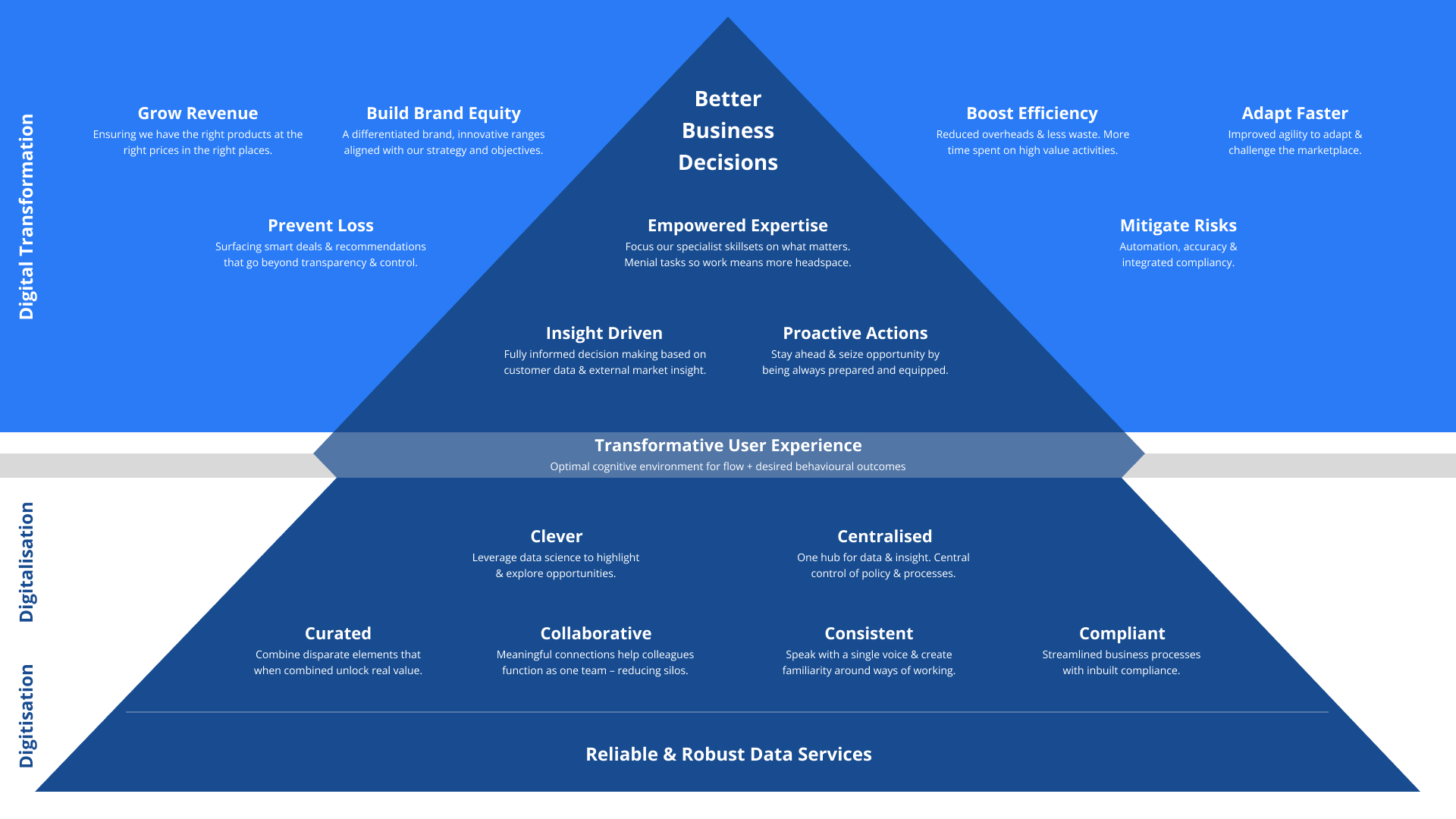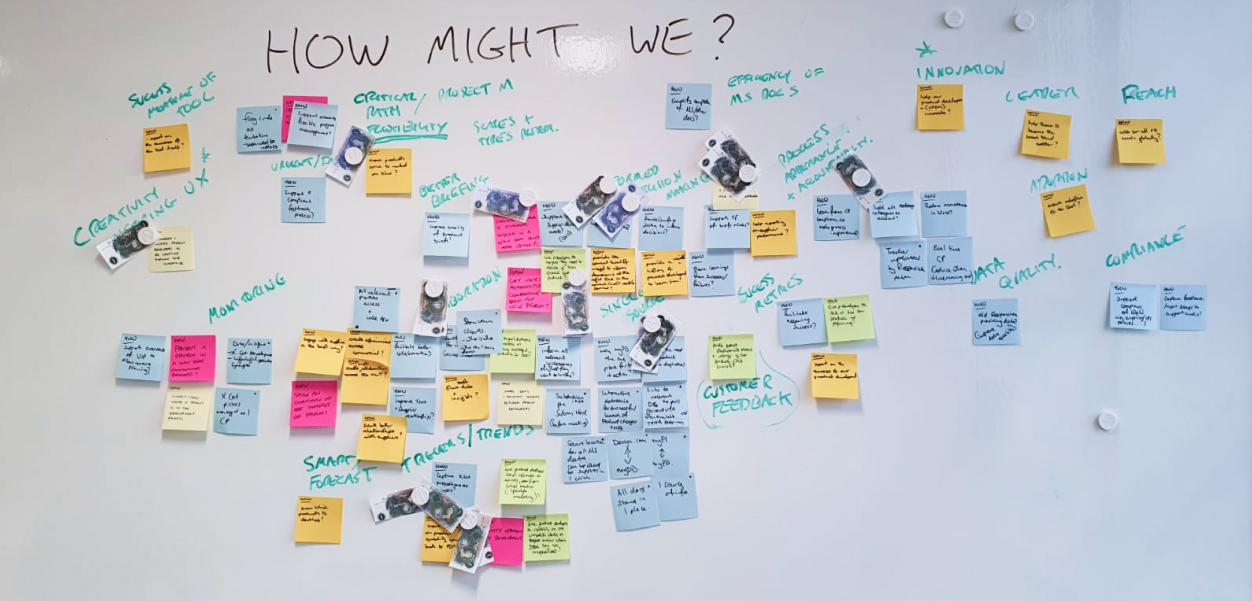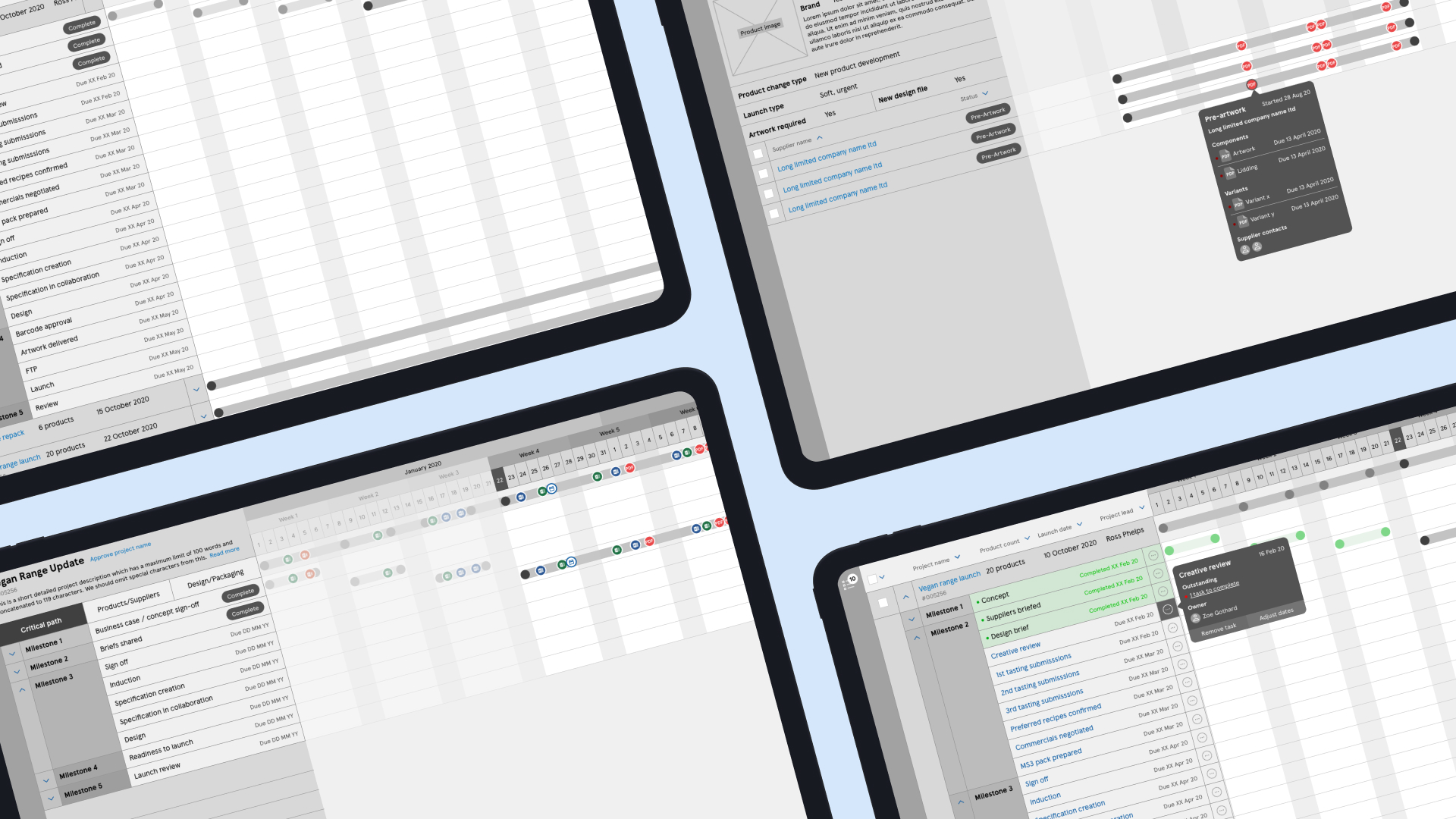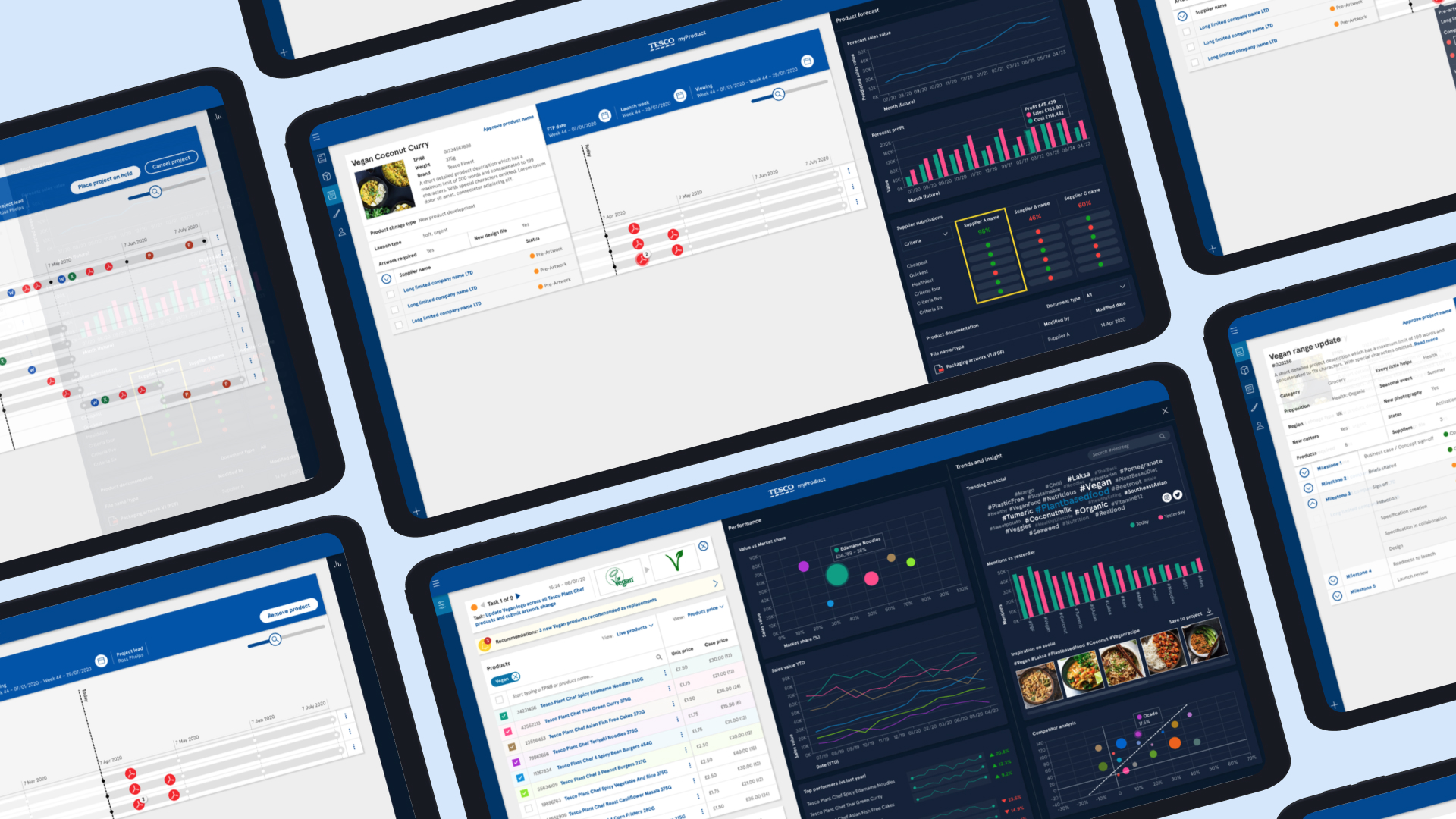
Delve into a captivating exploration of the UK’s leading retailer’s digital transformation. Through the art of storytelling, I navigated the challenges and triumphs of securing the pivotal funding for our initiative. This narrative isn’t just about innovation—it’s about defining a visionary enterprise platform, interweaving user needs, key business insights, and critical financial metrics. With one tantalising mission: Create the right product through collaboration and shared insight and elevate over 80 million customer interactions a week. As a Consultant and UX Design Lead, my year-long engagement within Tesco’s elite design team was nothing short of transformative. Reporting directly to the Head of Design, every chapter of this journey was charged with revelation. Curious to uncover more? Let’s dive in…

Tesco, a stalwart in the global retail sector, is not merely a household name but a brand of substantial magnitude. As showcased in recent data, Tesco’s Own Label emerges as the 24th biggest brand in the world, with an astonishing £15bn in sales, outstripping even renowned global brands such as Adidas, Ford, and IKEA. This figure, augmented by a profit of £5bn, offers a testament to the unparalleled reach and acceptance of the Tesco brand across the market spectrum.
Delving deeper into Tesco’s prodigious scale, the brand’s own-label products are a paramount contributor to its resounding success.
Extensive Portfolio: Over 11,000 unique own-label products.
Innovation: Annual addition of 6.5k products.
Investment: Refined and enhanced at a cost of £75m.
Operational Insight: Orchestrated through individual spreadsheets and legacy enterprise tools.
This case study will give a glimpse into the colossal scale and intricacies of Tesco’s own-brand operations and provide strategic insights into how I set the stage for innovative and effective user-centric solutions.

At Tesco, the path to digital transformation is not just a necessity but a pivotal strategy aimed at redefining internal enterprise operations. The depicted framework captures the essence of Tesco’s comprehensive digital shift, anchored on multiple crucial pillars. The organisation prioritises ‘Growing Revenue’ by ensuring the selection of the right products at optimal prices and ‘Building Brand Equity’ through innovative ranges. Equally vital is the drive to ‘Boost Efficiency’ by cutting overheads, facilitating more time for high-value activities, and the capacity to ‘Adapt Faster’, in an ever-evolving marketplace. The desired outcome of ‘Better Business Decisions’ empowers the organisation with ‘Insight Driven’ decision-making, fostering a culture of ‘Proactive Actions’ and leveraged opportunities, all the while equipping themselves to ‘Mitigate Risks’ through a refined governance process.
In my role as UX Design Lead for New Product Development, my engagement was to navigate this transformative strategy while defining and innovating a ‘Transformative User Experience’ that seamlessly improved functionality with desired behavioural outcomes. All enterprise tools were strategically ‘Curated’, combining features to maximise value, built on and built on a digitised foundation of ‘Reliable & Robust Data Services’. All outcomes must be ‘Collaborative’ and ‘Consistent’, ensuring streamlined communication across teams and enhancing productivity.
My team undertook the ambitious programme of converging a broad range of enterprise tools, blending digital with operational capabilities across key sectors such as Pricing, Cost Attribution, Range Setting, Quality Control, and New Product Development. The approach was to transition away from fragmented and compartmentalised product environments to a singular, human-centred enterprise solution. Through innovative, user-centric design methodologies, we established a uniform set of interaction behaviours, catering to every conceivable user scenario.
Our programme aim? Ensure customers always receive the right product exactly when they need it. By harnessing the power of data science, we analysed a vast array of metrics, from retail pricing, customer preferences, distribution statistics, invaluable customer feedback, industry insights, trading behaviours, and financial data. This comprehensive approach not only met but anticipated ever-evolving customer demands, providing a curated experience that was both meaningful and responsive.
At Tesco, the new product development process is intricately linked with an internal enterprise tool, “Develop”. This legacy platform caters to 15 core user groups, all of whom play a vital role in transforming a product idea into a tangible item on our shelves.
As UX Design Lead, I led the process in understanding and refining the user experience of “Develop”. The primary user of this tool is a “Product Developer”, who has the responsibility of kickstarting, managing and delivery of a multi-phased journey from concept to the plate of a customer, marked by key milestones.
It’s worth noting that the process, while robust, had many challenges for those that used it. The scale and complexity of the platforms and systems that underpinned it often made the process appear confusing and long-winded. For the discovery phase of the programme, my approach was to define the People, their Activities, the Context in which they exist, pinpoint their challenges, by understanding this it would unearth opportunities for improvement within newly converged set of Tools. This programme used a research framework called PACT and utilised the now classic HCD Double Diamond methodology.

Throughout the discovery phase, I closely partnered with my Product Manager to pinpoint the various users of “Develop” and understand their specific roles within the system. This collaboration paved the way for a series of discovery workshops. Intriguingly, this marked the first instance of actively enabling Product Developers to shape their own governance process. Leveraging tailored discussion guides and a set of structured workshop plans, I delved into their experiences, capturing their pain points, the aspects they favoured, and their jobs to be done using an empathy mapping methodology.
To supercharge my primary and secondary research, I conducted one-on-one interviews with users. These sessions employed a cognitive walkthrough technique, enabling me to chart out the primary needs, activities, and processes of a diverse user groups that encompassed suppliers, artworkers, manufacturers, and colleagues in planning and operations.
What I uncovered was an expansive set of pain points, processes and user needs that directly impact the wider business, product portfolio, and customer experience; as established through identifying of the size of the prize, at an estimated operational cost of £75m annually.
In the define phase of the approach, I delved deep into both primary and secondary research data, aiming to extract themes and key insights. This process refined an internal understanding of users, enabling their categorisation into distilled user groups. These groups were formed from well-defined needs, offering a clear perspective on crucial interactions like workflow dynamics, cross-functional teamwork, governance structures, process optimisation, and the overarching imperative of data-driven decision making. This foundational work set the stage for the development of comprehensive personas and the articulation of specific problem statements to tackle.
Insights from the user interviews proved invaluable. Certain quotes surfaced, shedding light on the pain points users encounter across various moments of their experience:

‘Data comes in different formats from different people and it takes time to sort through and analyse’

‘I have spreadsheets for every project that I own, but I don't think anyone else would understand them?’

‘We become the sales prevention team as nobody understands the amount of time it takes to do the work’

‘Who's accountable and what timelines they are working to would help suppliers’

‘Im only in my area for a year or 2 understanding the history of the category would be useful to cut the learning curve’
From the in-depth analysis, it’s evident that the current workflow, systems, governance, and user support are misaligned with best practices. The cognitive walkthroughs unveiled a fragmented and disjointed journey when transitioning a concept from ideation all the way through to in-store presentation. This end-to-end journey encompassed:
I facilitated multiple co-design workshops, engaging key stakeholders, end-users, and the broader team. Drawing on evidence from our in-depth research, we pinpointed opportunities for innovation. To ensure we were focusing our efforts effectively, I employed the MoSCoW prioritisation technique, complemented by dot voting; each participant was given a wad of [Fake] cash and asked to make an investment. This approach not only gave the team a clear understanding of critical issues but also enabled them to craft targeted ‘how might we’ (HMW) questions. These, in turn, formed the foundation for our hypothesis and well-defined problem statements, aligning our design efforts with user needs and strategic goals.

During the develop phase, I collaborated with key stakeholders for a series of three strategic vision workshops. These sessions were geared towards conceptualising how the newly integrated ‘Develop’ platform would harmoniously coexist with other Product Lifecycle Management (PLM) tools, namely ‘Induct’ and ‘Quality’. The insights from these sessions painted a picture of the envisioned enterprise suite. Collectively, we sculpted the strategy of ‘enhancing customer experiences through informed decision-making‘. We leaned into the compelling power of storytelling, leveraging videos and storyboards as mediums to vividly convey our concepts, aiming to elevate over 80 million customer interactions weekly.
I facilitated a creative ideation session with key user groups to craft user journeys. By introducing the innovative method of pop-up paper prototyping using the SAP Culture matters: The Innovation Culture Toolkit, I was able to visually articulate these journeys and establish their narrative. The results you can see in the below video!
I facilitated so many ideation workshops, framing central challenges and deploying ‘How Might We’ questions. I employed dynamic ideation methods like ‘Crazy 8’s‘ and the ‘Anti-problem‘. This immersive experience generated an array of forward-thinking ideas that resonated with our overarching vision. These innovative solutions were poised for validation. While some ideas were pragmatically viable, others required further refinement. A collaborative ‘dot voting’ exercise helped the team gravitate towards the most promising concepts. Our outcome became clear: ‘Create the right product through collaboration and shared insight‘.
The deliver phase started by crafting user journeys, merging quantitative usage data from the legacy ‘Develop’ systems with an refined governance process. These journeys were broken down into key moments for the wireframing stage, where I utilised Sketch to visualise the future-state user experience. At the core, the design encapsulated a visual project management interface, a visual hierarchy designed to empower users with an instantaneous comprehension of their project’s progression within the broader framework. I established multiple versions of this critical component, primed for Usability testing.

The refined governance process became the linchpin of each project. Evidenced by research, Product Developers often grappled with limited insights on their current projects, a pivotal introduction was the notification centre. This feature highlighted shifts in sales dynamics and flagged logistical challenges, thus serving as the linchpin of the journey. Capitalising on a treasure trove of available APIs, a critical moment in the user journey focused on identifying market trends, meaning ‘Develop’ could proactively suggest modifications to existing products, like pricing adjustments, or advocate for novel product introductions rooted in market research.
Collaboration emerged as the cornerstone of the design strategy. The platform was not only architected to keep users informed of project milestones but also proactively promoted cross-team collaboration. It sought to minimise administrative overheads, letting teams concentrate on core tasks. This vision was actualised via auto-generated documentation and digital approvals. Supplier briefs were autonomously crafted based on project-specific criteria and dispatched to designated suppliers. An embedded asynchronous chat feature facilitated seamless query resolutions. Furthermore, a scoring system was instituted for supplier submissions, which, in turn, facilitated the vision of data-driven decision-making.
One of the challenges I encountered was the endeavour to streamline and automate the expansive 20,000 input fields. A colossal undertaking, my squad and I worked tirelessly to distil these into mandatory datasets. The wireframes applied Tesco’s nascent internal design system, ‘Daisy’, which utilised a diverse array of charts powered by the D3 library. As ‘Daisy’ was in its formative stages, it was concurrently deployed across various value-centric projects, and feedback from these initiatives was continuously fed back to enhance and refine the system.

The plan was to design at speed, and test all the time, capturing any outcomes which provided value and ideating on points of failure. I conducted one-to-one. moderated usability tests to identify pain points within the experience, discovering areas where users struggle, encountered issues, or became frustrated. These findings allowed me to pinpoint specific parts of the interface, interactions or flow that need improvement. Sharing usability testing results with stakeholders and the broader team helped can help align everyone on ever evolving design priorities. Observing ‘Develop’s’ users interact with a product was be a powerful tool for building empathy and making a case for future user-centric design changes.
To secure funding for the “Develop” initiative, a step crucial to all programmes at Tesco, I employed a powerful storytelling technique, leveraging storyboards to vividly convey our envisioned future. Coupling this with a projection of its financial impact not only achieved the desired results but also set a precedent, inspiring other transformational programmes to adopt a similar narrative-driven approach. Drawing from my passion for sketching, I crafted the journey of Penny, our Product Developer. After refining these initial sketches, I digitalised them into brand-friendly visuals and presented a compelling narrative to our executive leadership. Their overwhelming positive feedback was testament to the power of well-crafted storytelling in decision-making. I trust this approach will resonate with you as much as it did with them.